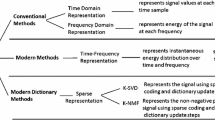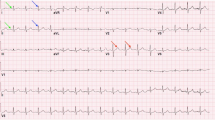Abstract
Appropriate signal representation is the fundamental issue of concern in all signal processing-based applications. For instance, in the context of signal compression one would require the signal representation to be such that most of the information is confined in the smallest subspace with least number of coefficients. In classification scenario, the representation has to be such that it accentuates differential information amongst classes. In the context of applications dealing with signal decomposition or denoising, one would require the representation such that it separates the input into its independent components so that individual components, i.e. the signal and noise lie in separate spaces. In this paper, we propose signal representation scheme that can be regarded as generalised KLT for multi-class scenario. We introduce an approach that would find the differential information between two classes rather than modelling individual classes separately. These classes are viewed on a common frame of reference in which one class would have a constant variance, unlike the other class which would have unequal variance along its basis vectors which would capture the differential information of one class over the other. This, when mathematically formulated, leads to the solution of the Matrix Pencil equation. This is borne out by illustrative examples on the classification of the MNIST (Deng in IEEE Signal Process Mag 29(6):141–142, 2012) and Google Speech Command Dataset (Pete in Software Engineer, G.B.T. Google Speech Command Dataset. https://ai.googleblog.com/2017/08/launching-speech-commands-dataset.html, 2017). Its applicability for biomedical data like brain state transition detection has also been explored and recorded.



Similar content being viewed by others
Data Availability
This is to declare that all the data used for the above research is open source and has been cited. This paper uses four datasets for different applications. The MNIST [6] and Google Speech Command Dataset [17] have been used for classification and multiclass signal representation-related applications. MPEG-7 Core Experiment CE-Shape-1 Test Set [8] has been used for transformation of one pattern to another and the dataset from Texas Data Repository [24] for activity detection.
References
S. An, M. Lee, S. Park, H. Yang, J. So, An ensemble of simple convolutional neural network models for mnist digit recognition. arXiv preprint arXiv:2008.10400 (2020)
M. Bhuiyan, E.V. Malyarenko, M.A. Pantea, F.M. Seviaryn, R.G. Maev, Advantages and limitations of using matrix pencil method for the modal analysis of medical percussion signals. IEEE Trans. Biomed. Eng. 60(2), 417–426 (2012)
P.R. Cavalin, A. de Souza Britto Jr, F. Bortolozzi, R. Sabourin, L.E.S. Oliveira, An implicit segmentation-based method for recognition of handwritten strings of characters, in Proceedings of the 2006 ACM Symposium on Applied Computing, pp. 836–840 (2006)
G. Cohen, S. Afshar, J. Tapson, A. Van Schaik, Emnist: extending mnist to handwritten letters, in 2017 International Joint Conference on Neural Networks, IEEE, pp. 2921–2926 (2017)
D.C. de Andrade, S. Leo, M.L.D.S. Viana, C. Bernkopf, A neural attention model for speech command recognition. arXiv preprint arXiv:1808.08929 (2018)
L. Deng, The mnist database of handwritten digit images for machine learning research [best of the web]. IEEE Signal Process. Mag. 29(6), 141–142 (2012)
P. Ghadekar, S. Ingole, D. Sonone, Handwritten digit and letter recognition using hybrid DWT-DCT with KNN and SVM classifier, in Fourth International Conference on Computing Communication Control and Automation, IEEE, pp. 1–6 (2018)
Group, C.I. Mpeg-7 core experiment ce-shape-1 test set. benchmarking image database for shape recognition techniques. http://www.ehu.eus/ccwintco/index.php/MPEG-7_Core_Experiment_CE-Shape-1_Test_Set._Benchmarking_image_database_for_shape_recognition_techniques
N. Hermann, What is the function of the various brainwaves. Sci. Am. 22, 1 (1997)
H. Hermansky, N. Morgan, A. Bayya, P. Kohn, Rasta-PLP speech analysis. Proceedings of IEEE International Conference of Acoustics, Speech and Signal Processing 1, 121–124 (1991)
M. Khodjet-Kesba, K.E.K. Drissi, S. Lee, K. Kerroum, C. Faure, C. Pasquier, Comparison of matrix pencil extracted features in time domain and in frequency domain for radar target classification (Int. J, Antennas Propag, 2014)
B. Kim, S. Chang, J. Lee, D. Sung, Broadcasted residual learning for efficient keyword spotting. arXiv preprint arXiv:2106.04140 (2021)
Y. Liu, Z. Nie, Q.H. Liu, Reducing the number of elements in a linear antenna array by the matrix pencil method. IEEE Trans. Antennas Propag. 56(9), 2955–2962 (2008)
K. Lu, C.S. Foo, K.K. Teh, H.D. Tran, V.R. Chandrasekhar, Semi-supervised audio classification with consistency-based regularization, in INTERSPEECH, pp. 3654–3658 (2019)
V. Mazzia, F. Salvetti, M. Chiaberge, Efficient-capsnet: capsule network with self-attention routing. arXiv preprint arXiv:2101.12491 (2021)
Y. Peng, H. Yin, Markov random field based convolutional neural networks for image classification, in International Conference on Intelligent Data Engineering and Automated Learning, Springer, pp. 387–396 (2017)
W. Pete, Software Engineer, G.B.T. Google speech command dataset. https://ai.googleblog.com/2017/08/launching-speech-commands-dataset.html (2017)
S. Sabour, N. Frosst, G.E. Hinton, Dynamic routing between capsules, in Advances in Neural Information Processing Systems, pp. 3856–3866 (2017)
T.K. Sarkar, S. Park, J. Koh, S.M. Rao, Application of the matrix pencil method for estimating the SEM (singularity expansion method) poles of source-free transient responses from multiple look directions. IEEE Trans. Antennas Propag. 48(4), 612–618 (2000)
T.K. Sarkar, O. Pereira, Using the matrix pencil method to estimate the parameters of a sum of complex exponentials. IEEE Antennas Propag. Mag. 37(1), 48–55 (1995)
D. Seo, H.S. Oh, Y. Jung, Wav2kws: transfer learning from speech representations for keyword spotting. IEEE Access 9, 80682–80691 (2021)
R. Sharma, M. Mishra, J. Nayak, B. Naik, D. Pelusi, Innovation in Electrical Power Engineering, Communication, and Computing Technology: Proceedings of IEPCCT 2019, vol. 630, Springer Nature (2020)
A. Shawon, M.J.U. Rahman, F. Mahmud, M.A. Zaman, Bangla handwritten digit recognition using deep CNN for large and unbiased dataset, in 2018 International Conference on Bangla Speech and Language Processing, IEEE, pp. 1–6 (2018)
L. Trujillo, Raw BDF data (2017)
L.T. Trujillo, C.T. Stanfield, R.D. Vela, The effect of electroencephalogram (EEG) reference choice on information-theoretic measures of the complexity and integration of EEG signals. Front. Neurosci. 11, 425 (2017)
P. Warden, Speech commands: a dataset for limited-vocabulary speech recognition. arXiv preprint arXiv:1804.03209 (2018)
R. Zimmer, T. Pellegrini, S.F. Singh, T. Masquelier, Technical report: supervised training of convolutional spiking neural networks with pytorch. arXiv preprint arXiv:1911.10124 (2019)
Author information
Authors and Affiliations
Corresponding author
Ethics declarations
Conflict of interest
The authors declare that they have no conflict of interest.
Additional information
Publisher's Note
Springer Nature remains neutral with regard to jurisdictional claims in published maps and institutional affiliations.
Rights and permissions
Springer Nature or its licensor (e.g. a society or other partner) holds exclusive rights to this article under a publishing agreement with the author(s) or other rightsholder(s); author self-archiving of the accepted manuscript version of this article is solely governed by the terms of such publishing agreement and applicable law.
About this article
Cite this article
Bhagat, S., Joshi, S.D. Quantification of Differential Information Using Matrix Pencil and Its Applications. Circuits Syst Signal Process 42, 2169–2192 (2023). https://doi.org/10.1007/s00034-022-02198-x
Received:
Revised:
Accepted:
Published:
Issue Date:
DOI: https://doi.org/10.1007/s00034-022-02198-x




